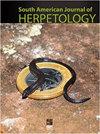Detectability of Caiman latirostris (Crocodylia: Alligatoridae) in Night Count Surveys
IF 0.7
4区 生物学
Q4 ZOOLOGY
引用次数: 0
Abstract
Abstract. Night count surveys are one of the most used methods to study distribution and population parameters in crocodilians. However, there are some methodological constraints that prevent the visualization of animals submerged or hidden behind vegetation. We studied the proportion of caimans that were detectable to observers during night count surveys based on the monitoring of seven adult Caiman latirostris females with radio transmitters (VHF, GPS, and UHF). Fieldwork was carried out in a protected area with a natural stream and a lagoon (30°11′26″S, 61°00′27″W) between 12 January and 29 April 2011 in Santa Fe, Argentina. Only locations acquired at night (18:00–05:00) were considered for analysis, and those acquired within vegetation were considered potentially undetectable. As the lagoon is mostly covered with vegetation (e.g., cattail), most of the animals were not visible to observers (62.5–100%, average > 80%). In contrast, virtually all individuals (100%) were potentially visible in the stream. The use of data collected in telemetry studies can be useful to estimate detectability of cryptic species such as the broad-snouted caiman. An understanding of animal detectability is necessary, as counts of individuals is often used in decision-making for crocodilian conservation, sustainable use, and control.夜间调查中鳄鱼科凯门鳄的可检出性
摘要夜间计数调查是研究鳄鱼分布和种群参数最常用的方法之一。然而,存在一些方法上的限制,阻碍了对淹没或隐藏在植被后面的动物的可视化。我们研究了在夜间计数调查中观察者可检测到的凯门鳄的比例,该调查基于对七只成年凯门鳄雌性的无线电发射机(VHF、GPS和UHF)监测。2011年1月12日至4月29日,在阿根廷圣达菲的一个有天然溪流和泻湖(南30°11′26〃,西61°00′27〃)的保护区进行了实地调查。只考虑在夜间(18:00–05:00)采集的位置进行分析,而在植被内采集的位置被认为可能无法检测到。由于泻湖大部分被植被(如香蒲)覆盖,观察者看不到大多数动物(62.5-100%,平均>80%)。相比之下,几乎所有的个体(100%)都可能在流中可见。利用遥测研究中收集的数据可以用来估计宽吻凯门鳄等神秘物种的可探测性。了解动物的可检测性是必要的,因为个体数量通常用于鳄鱼保护、可持续利用和控制的决策。
本文章由计算机程序翻译,如有差异,请以英文原文为准。
求助全文
约1分钟内获得全文
求助全文
来源期刊
CiteScore
1.50
自引率
0.00%
发文量
10
期刊介绍:
The South American Journal of Herpetology (SAJH) is an international journal published by the Brazilian Society of Herpetology that aims to provide an effective medium of communication for the international herpetological community. SAJH publishes peer-reviewed original contributions on all subjects related to the biology of amphibians and reptiles, including descriptive, comparative, inferential, and experimental studies and taxa from anywhere in the world, as well as theoretical studies that explore principles and methods.

 求助内容:
求助内容: 应助结果提醒方式:
应助结果提醒方式:


